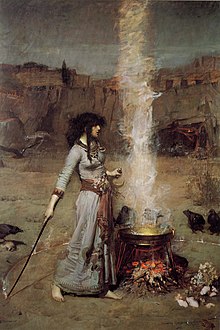جادوگری
Appearance

جادوگری (انگریزی: Witchcraft) روایتی طور پر دوسروں کو نقصان پہنچانے کے لیے جادو یا مافوق الفطرت طاقتوں کا استعمال ہے۔ [1][2]
مزید دیکھیے
[ترمیم]حوالہ جات
[ترمیم]- ↑ Keith Thomas (1997)۔ Religion and the Decline of Magic۔ Oxford, England: اوکسفرڈ یونیورسٹی پریس۔ صفحہ: 519۔ ISBN 978-0-297-00220-8۔
'At this day'، wrote Reginald Scot in 1584, 'it is indifferent to say in the English tongue, "she is a witch" or "she is a wise woman"۔' Nevertheless, it is possible to isolate that kind of 'witchcraft' which involved the employment (or presumed employment) of some occult means of doing harm to other people in a way which was generally disapproved of. In this sense the belief in witchcraft can be defined as the attribution of misfortune to occult human agency. A witch was a person of either sex (but more often female) who could mysteriously injure other people.
- ↑ Ronald Hutton (2017)۔ The Witch: A History of Fear, from Ancient Times to the Present۔ Yale University Press۔ صفحہ: ix۔
What is a witch? The standard scholarly definition of one was summed up in 1978 by a leading expert in the anthropology of religion, Rodney Needham, as 'someone who causes harm to others by mystical means'۔ In stating this, he was self-consciously not providing a personal view of the matter, but summing up an established scholarly consensus […] When the only historian of the European trials to set them systematically in a global context in recent years, Wolfgang Behringer, undertook his task, he termed witchcraft 'a generic term for all kinds of evil magic and sorcery, as perceived by contemporaries'۔ Again, in doing so he was self-consciously perpetuating a scholarly norm. That usage has persisted till the present among anthropologists and historians.۔۔
